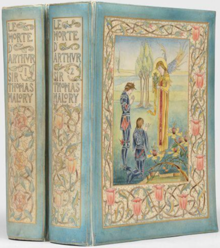
Back موت آرثر (عمل أدبي) Arabic Смъртта на Артур Bulgarian Le Morte d'Arthur Breton La mort d'Artús Catalan Artušova smrt Czech Le Morte d'Arthur Welsh Le Morte Darthur German Ο θάνατος του Αρθούρου Greek La muerte de Arturo Spanish Le Morte d’Arthur Finnish
This article may require copy editing for grammar, style, cohesion, tone, or spelling. (October 2024) |
 The two volumes of an illustrated edition of Le Morte D'Arthur published by J. M. Dent in 1893, with vellucent binding by Cedric Chivers | |
| Author | Thomas Malory |
|---|---|
| Original title | Le morte Darthur |
| Language | Middle English |
| Subject | Matter of Britain |
| Genre | Chivalric romance, sword and sorcery, historical fantasy |
| Published | 1485 |
| Publisher | William Caxton |
| Publication place | Kingdom of England |
| 823.2 | |
| LC Class | PR2043 .B16 |
| Text | Le Morte d'Arthur at Wikisource |
Le Morte d'Arthur (originally written as le morte Darthur; Anglo-Norman French for "The Death of Arthur")[1] is a 15th-century Middle English prose reworking by Sir Thomas Malory of tales about the legendary King Arthur, Guinevere, Lancelot, Merlin and the Knights of the Round Table, along with their respective folklore. In order to tell a "complete" story of Arthur from his conception to his death, Malory compiled, rearranged, interpreted and modified material from various French and English sources. Today, this is one of the best-known works of Arthurian literature. Many authors since the 19th-century revival of the legend have used Malory as their principal source.
Apparently written in prison at the end of the medieval English era, Le Morte d'Arthur was completed by Malory around 1470 and was first published in a printed edition in 1485 by William Caxton. Until the discovery of the Winchester Manuscript in 1934, the 1485 edition was considered the earliest known text of Le Morte d'Arthur and that closest to Malory's original version.[2] Modern editions under myriad titles are inevitably variable, changing spelling, grammar and pronouns for the convenience of readers of modern English, as well as often abridging or revising the material.
- ^ The article le would be ungrammatical in modern French since morte (or mort) is a feminine noun, for which French requires the article la (i.e., "la mort d'Arthur"). According to Stephen Shepherd, "Malory frequently misapplies le in titular compounds, perhaps on a simple sonic and gender-neutral analogy with 'the'." Stephen H. A. Shepherd, ed., Le Morte Darthur, by Sir Thomas Malory (New York: Norton, 2004), 1n. However, in Anglo-Norman, "the feminine la was often reduced to le, especially in the later period" (thirteenth century and later), Mildred K. Pope, From Latin to Modern French with Especial Consideration of Anglo-Norman: Phonology and Morphology (Manchester UK: University Press, 1934), paragraph 1252.iii (p. 30).
- ^ Bryan, Elizabeth J. (1994–1999). Introduction. Le morte d'Arthur. By Malory, Thomas (Modern Library ed.). New York: Modern Library. p. vii. ISBN 0-679-60099-X.